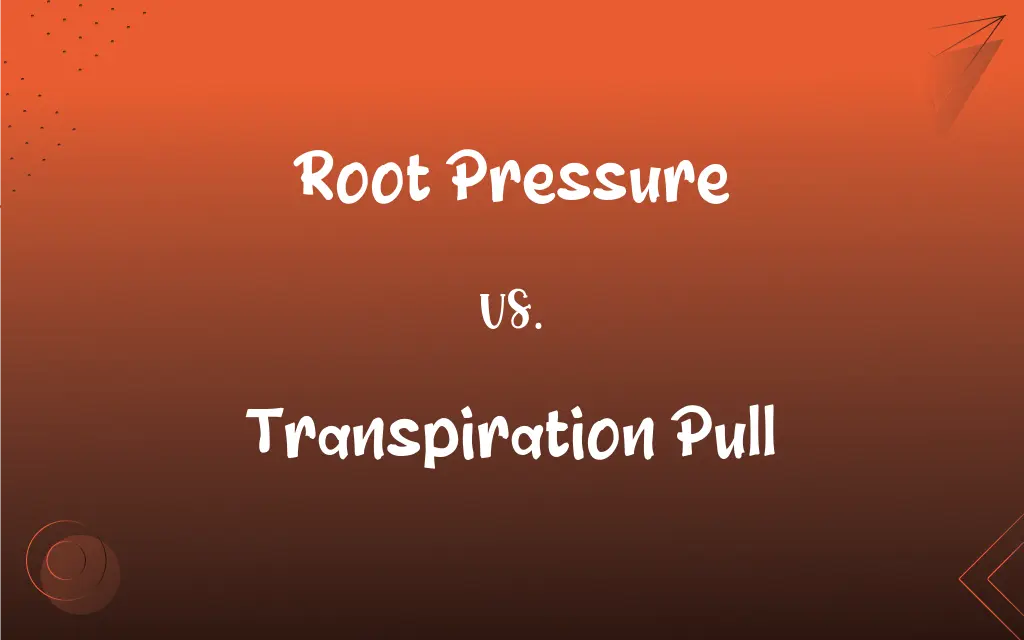Root Pressure vs. Transpiration Pull: What's the Difference?
Edited by Aimie Carlson || By Janet White || Published on February 4, 2024
Root pressure is the upward push of water within plants due to water intake from roots, while transpiration pull is the upward movement of water driven by water vapor loss from leaves.

Key Differences
Root pressure is generated when water is absorbed by the roots from the soil, creating an upward force. Transpiration pull occurs when water evaporates from the leaves, creating a negative pressure that draws water up.
Root pressure helps in the initial upward movement of water in plants, especially under conditions of high soil moisture. Transpiration pull is the primary mechanism for water movement in tall plants, utilizing the cohesive properties of water.
Root pressure is more evident at night or in the absence of transpiration. Transpiration pull is influenced by environmental factors like humidity, temperature, and wind.
Root pressure is crucial in rehydrating plant tissues and maintaining nutrient flow. Transpiration pull is essential for the transport of water and minerals from roots to leaves.
Root pressure can be observed in guttation, where droplets form on leaf edges. Transpiration pull can be inferred from the movement of water in xylem under a microscope.
ADVERTISEMENT
Comparison Chart
Driving Force
Water intake by roots
Evaporation of water from leaves
Primary Mechanism
Pushes water upwards
Pulls water upwards
Active During
Night or low transpiration conditions
Daytime, when transpiration rate is high
Environmental Influence
Less influenced by external factors
Highly influenced by humidity, temperature
Role in Plant
Rehydration, nutrient flow
Water and mineral transport
ADVERTISEMENT
Root Pressure and Transpiration Pull Definitions
Root Pressure
Root pressure is the osmotic pressure within the roots that pushes water upward.
Root pressure was evident in the morning dew on the plant's leaves.
Transpiration Pull
Transpiration pull is observed in the movement of water in the xylem.
Microscopic observation revealed the dynamics of transpiration pull in action.
Root Pressure
Root pressure assists in the upward movement of water in small plants.
Root pressure was responsible for the moisture at the tips of the grass blades.
Transpiration Pull
Transpiration pull is a major factor in water transport in tall plants.
The towering redwoods relied heavily on transpiration pull for hydration.
Root Pressure
Root pressure is independent of transpiration processes.
Even at night, root pressure maintained the plant's turgidity.
Transpiration Pull
Transpiration pull is influenced by environmental factors like sunlight and wind.
On windy days, the transpiration pull increased, requiring more water uptake.
Root Pressure
Root pressure occurs when roots absorb water, creating a pressure gradient.
The root pressure in the sapling helped it recover from wilting.
Transpiration Pull
Transpiration pull is the force generated by water evaporation from plant leaves.
Transpiration pull was essential for transporting nutrients to the tree's canopy.
Root Pressure
Root pressure is observed through guttation in some plants.
The tiny droplets on the leaf edges indicated strong root pressure.
Transpiration Pull
Transpiration pull creates a negative pressure, facilitating water movement.
The plant's extensive root system supported the transpiration pull effectively.
FAQs
Does root pressure operate during the day?
It's more active during the night or when transpiration is low.
How does root pressure assist plants?
It helps in the upward movement of water and nutrients, especially in small plants.
Can root pressure cause guttation?
Yes, root pressure can lead to guttation, where droplets form on leaf edges.
What is root pressure?
Root pressure is the upward force created by water absorption in plant roots.
Does wind affect transpiration pull?
Yes, wind increases the rate of transpiration and thus the transpiration pull.
Is transpiration pull important in tall trees?
Yes, it's crucial for water movement in tall trees.
How is transpiration pull measured?
It's often inferred from water movement in the xylem and environmental conditions.
What causes transpiration pull?
Transpiration pull is caused by the evaporation of water from plant leaves.
Is root pressure enough for water movement in large plants?
No, in large plants, transpiration pull is the primary driver for water movement.
Does transpiration pull involve energy expenditure by the plant?
Transpiration pull is a passive process and doesn't require direct energy expenditure.
What happens to root pressure in drought conditions?
Root pressure decreases in drought conditions due to reduced water availability.
Can root pressure be influenced by nutrient concentration?
Yes, high nutrient concentration in soil can enhance root pressure.
Can transpiration pull occur at night?
Transpiration pull is significantly reduced at night due to lower rates of transpiration.
What role does osmosis play in root pressure?
Osmosis is crucial for root pressure, as it facilitates water absorption into roots.
How does leaf structure affect transpiration pull?
Leaf structure, such as stomatal density, affects the rate of transpiration and consequently the transpiration pull.
How do environmental conditions affect root pressure?
Root pressure is less affected by external conditions and more by soil moisture levels.
Is transpiration pull affected by plant species?
Yes, different species have varying transpiration rates, affecting the strength of transpiration pull.
Can root pressure be observed directly?
Root pressure is indirectly observed through phenomena like guttation.
Is transpiration pull a continuous process?
Transpiration pull is continuous but varies in intensity based on environmental conditions and time of day.
What factors affect transpiration pull?
Humidity, temperature, wind, and sunlight influence it.
About Author
Written by
Janet WhiteJanet White has been an esteemed writer and blogger for Difference Wiki. Holding a Master's degree in Science and Medical Journalism from the prestigious Boston University, she has consistently demonstrated her expertise and passion for her field. When she's not immersed in her work, Janet relishes her time exercising, delving into a good book, and cherishing moments with friends and family.
Edited by
Aimie CarlsonAimie Carlson, holding a master's degree in English literature, is a fervent English language enthusiast. She lends her writing talents to Difference Wiki, a prominent website that specializes in comparisons, offering readers insightful analyses that both captivate and inform.































































